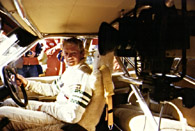
Racecam TV sport coverage
1979
live television broadcast from racing cars
Racecam gives TV viewers a driver's eye view of the action on the car racing circuit. Channel 7 introduced the system at the Bathurst 1000 car race in 1979. Racecam pioneered the live broadcast of TV images from racing cars, using a network of car-mounted cameras, miniaturised microwave radio transmitters, and relays in helicopters.
Refinements like 'Bumpercam' (mounted on the car bumper) and the 'Clearview' system (which removes grit and dust from the lens) have been licensed to broadcasters overseas to add to the thrill of armchair race driving all over the world.
Racecams have been used in motorcycle racing since 1992.
Other sports haven't missed out. Stumpcam for cricket, basketball's 'slamcam', snow skicam and a host of variations have been developed to take viewers right into the action.
Who Did It?
Key Organisations
ATN Channel 7 : funding, implementation
Mitec Ltd : microwave antenna design
Key People
Geoff Healy : development team leader
Don MacPherson : operation
John Porter : researcher
Further Reading
A practical guide to technology: from pigs to optical fibres
Melvin Freestone & Vernon Nase
1993, pp 57-62
Links
Racecam car video systems
Mt Panorama V8 Supercar 1000, Bathurst
Questions & Activities
Racecam TV sport coverage
Related Innovations
World Series Cricket
|











